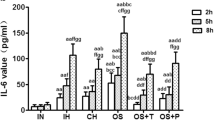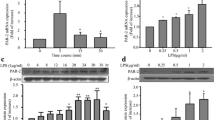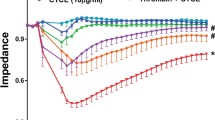Abstract
Objective and design
Hypoxia may enhance the deleterious effects of lipopolysaccharide (LPS) in the endotoxaemic horse. This study has examined some of the actions of LPS and hypoxia, alone and in combination, on cultured equine digital vein endothelial cells (EDVEC) and the signalling molecules involved.
Methods
EDVEC were exposed to LPS, 5% O2 and LPS then 5% O2 for up to 24 h. HIF-1α stabilisation, neutrophil adhesion and EDVEC permeability were assessed by immunoblotting, measurement of myeloperoxidase and movement of FITC-dextran, respectively. Pharmacological inhibitors were used to assess the roles of p38 MAPK and HIF-1α.
Results
LPS and hypoxia significantly increased HIF-1α stabilisation, neutrophil adhesion and EDVEC permeability and the effects of the two stimuli in combination on HIF-1α stabilisation and neutrophil adhesion were more than additive. The effect of LPS, but not 5% O2, on neutrophil adherence required activation of p38 MAPK, whereas EDVEC permeability in response to both stimuli was dependent on p38 MAPK and HIF-1α.
Conclusions
Exposure of EDVEC to LPS prior to induction of hypoxia up-regulates responses that may enhance LPS-induced tissue damage in the endotoxaemic horse. Inhibitors of p38 MAPK or HIF-1α could reduce such unwanted effects.






Similar content being viewed by others
References
King JN, Gerring EL. Detection of endotoxin in cases of equine colic. Vet Rec. 1988;123:269–71.
Perkins NR, Frazer GS. Reproductive emergencies in the mare. Vet Clin North Am Equine Pract. 1994;10:643–70.
Hood DM, Wagner IP, Brumbaugh GW. Evaluation of hoof wall surface temperature as an index of digital vascular perfusion during the prodromal and acute phases of carbohydrate-induced laminitis in horses. Am J Vet Res. 2001;62:1167–72.
Menzies-Gow NJ, Bailey SR, Katz LM, Marr CM, Elliott J. Endotoxin-induced digital vasoconstriction in horses: associated changes in plasma concentrations of vasoconstrictor mediators. Equine Vet J. 2004;36:273–8.
Simon MC, Liu L, Barnhart BC, Young RM. Hypoxia-induced signaling in the cardiovascular system. Annu Rev Physiol. 2008;70:51–71.
Mi Z, Rapisarda A, Taylor L, Brooks A, Creighton-Gutteridge M, Melillo G, et al. Synergystic induction of HIF-1alpha transcriptional activity by hypoxia and lipopolysaccharide in macrophages. Cell Cycle. 2008;7:232–41.
Frede S, Stockmann C, Freitag P, Fandrey J. Bacterial lipopolysaccharide induces HIF-1 activation in human monocytes via p44/42 MAPK and NF-kappaB. Biochem J. 2006;396:517–27.
Blouin CC, Page EL, Soucy GM, Richard DE. Hypoxic gene activation by lipopolysaccharide in macrophages: implication of hypoxia-inducible factor 1alpha. Blood. 2004;103:1124–30.
Ten VS, Pinsky DJ. Endothelial response to hypoxia: physiologic adaptation and pathologic dysfunction. Curr Opin Crit Care. 2002;8:242–50.
Yan SF, Ogawa S, Stern DM, Pinsky DJ. Hypoxia-induced modulation of endothelial cell properties: regulation of barrier function and expression of interleukin-6. Kidney Int. 1997;51:419–25.
Cahill PA, Redmond EM, Sitzmann JV. Endothelial dysfunction in cirrhosis and portal hypertension. Pharmacol Ther. 2001;89:273–93.
Shreeniwas R, Koga S, Karakurum M, Pinsky D, Kaiser E, Brett J, et al. Hypoxia-mediated induction of endothelial cell interleukin-1 alpha. An autocrine mechanism promoting expression of leukocyte adhesion molecules on the vessel surface. J Clin Invest. 1992;90:2333–9.
Kokura S, Rhoads CA, Wolf RE, Yoshikawa T, Granger DN, Aw TY. NF kappa b signaling in posthypoxic endothelial cells: relevance to E-selectin expression and neutrophil adhesion. J Vasc Res. 2001;38:47–58.
Tsiotou AG, Sakorafas GH, Anagnostopoulos G, Bramis J. Septic shock; current pathogenetic concepts from a clinical perspective. Med Sci Monit. 2005;11:RA76–85.
Brooks AC, Menzies-Gow NJ, Bailey SR, Cunningham FM, Elliott J. Endotoxin-induced activation of equine digital vein endothelial cells: role of p38 MAPK. Vet Immunol Immunopathol. 2009;129:174–80.
Black SJ, Lunn DP, Yin C, Hwang M, Lenz SD, Belknap JK. Leukocyte emigration in the early stages of laminitis. Vet Immunol Immunopathol. 2006;109:161–6.
Loftus JP, Belknap JK, Black SJ. Matrix metalloproteinase-9 in laminae of black walnut extract treated horses correlates with neutrophil abundance. Vet Immunol Immunopathol. 2006;113:267–76.
Herbert JM, Corseaux D, Lale A, Bernat A. Hypoxia primes endotoxin-induced tissue factor expression in human monocytes and endothelial cells by a PAF-dependent mechanism. J Cell Physiol. 1996;169:290–9.
Luyendyk JP, Shaw PJ, Green CD, Maddox JF, Ganey PE, Roth RA. Coagulation-mediated hypoxia and neutrophil-dependent hepatic injury in rats given lipopolysaccharide and ranitidine. J Pharmacol Exp Ther. 2005;314:1023–31.
Devlin LA, Nguyen MD, Figueroa E, Gordon LE, Feldhoff PW, Lassiter HA. Effects of endotoxin administration and cerebral hypoxia-ischemia on complement activity and local transcriptional regulation in neonatal rats. Neurosci Lett. 2005;390:109–13.
Bailey SR, Wheeler-Jones C, Elliott J. Uptake of 5-hydroxytryptamine by equine digital vein endothelial cells: inhibition by amines found in the equine caecum. Equine Vet J. 2003;35:164–9.
Rickards KJ, Page CP, Lees P, Cunningham FM. Differential inhibition of equine neutrophil function by phosphodiesterase inhibitors. J Vet Pharmacol Ther. 2001;24:275–81.
Dachs GU, Steele AJ, Coralli C, Kanthou C, Brooks AC, Gunningham SP, et al. Anti-vascular agent Combretastatin A-4-P modulates hypoxia inducible factor-1, gene expression. BMC Cancer. 2006;6:280.
Brooks AC, Menzies-Gow NJ, Wheeler-Jones C, Bailey SR, Cunningham FM, Elliott J. Endotoxin-induced activation of equine platelets: evidence for direct activation of p38 MAPK pathways and vasoactive mediator production. Inflamm Res. 2007;56:154–61.
Kanthou C, Tozer GM. The tumor vascular targeting agent combretastatin A-4-phosphate induces reorganization of the actin cytoskeleton and early membrane blebbing in human endothelial cells. Blood. 2002;99:2060–9.
Mabjeesh NJ, Post DE, Willard MT, Kaur B, Van Meir EG, Simons JW, et al. Geldanamycin induces degradation of hypoxia-inducible factor 1alpha protein via the proteosome pathway in prostate cancer cells. Cancer Res. 2002;62:2478–82.
Yeh WL, Lu DY, Lin CJ, Liou HC, Fu WM. Inhibition of hypoxia-induced increase of blood-brain barrier permeability by YC-1 through the antagonism of HIF-1alpha accumulation and VEGF expression. Mol Pharmacol. 2007;72:440–9.
Lau CK, Yang ZF, Lam CT, Tam KH, Poon RT, Fan ST. Suppression of hypoxia inducible factor-1alpha (HIF-1alpha) by YC-1 is dependent on murine double minute 2 (Mdm2). Biochem Biophys Res Commun. 2006;348:1443–8.
Pinsky DJ, Yan SF, Lawson C, Naka Y, Chen JX, Connolly ES Jr, et al. Hypoxia and modification of the endothelium: implications for regulation of vascular homeostatic properties. Semin Cell Biol. 1995;6:283–94.
Carmeliet P, Dor Y, Herbert JM, Fukumura D, Brusselmans K, Dewerchin M, et al. Role of HIF-1alpha in hypoxia-mediated apoptosis, cell proliferation and tumour angiogenesis. Nature. 1998;394:485–90.
Kim KS, Rajagopal V, Gonsalves C, Johnson C, Kalra VK. A novel role of hypoxia-inducible factor in cobalt chloride- and hypoxia-mediated expression of IL-8 chemokine in human endothelial cells. J Immunol. 2006;177:7211–24.
Dery MA, Michaud MD, Richard DE. Hypoxia-inducible factor 1: regulation by hypoxic and non-hypoxic activators. Int J Biochem Cell Biol. 2005;37:535–40.
Galbraith SM, Chaplin DJ, Lee F, Stratford MR, Locke RJ, Vojnovic B, et al. Effects of combretastatin A4 phosphate on endothelial cell morphology in vitro and relationship to tumour vascular targeting activity in vivo. Anticancer Res. 2001;21:93–102.
Triantafyllou A, Liakos P, Tsakalof A, Georgatsou E, Simos G, Bonanou S. Cobalt induces hypoxia-inducible factor-1alpha (HIF-1alpha) in HeLa cells by an iron-independent, but ROS-, PI-3 K- and MAPK-dependent mechanism. Free Radic Res. 2006;40:847–56.
Sprouse RF, Garner HE, Green EM. Plasma endotoxin levels in horses subjected to carbohydrate induced laminitis. Equine Vet J. 1987;19:25–8.
Menzies-Gow NJ, Sepulveda MF, Bailey SR, Cunningham FM, Elliott J. Roles of thromboxane A2 and 5-hydroxytryptamine in endotoxin-induced digital vasoconstriction in horses. Am J Vet Res. 2008;69:199–207.
Kim SH, Kim J, Sharma RP. Inhibition of p38 and ERK MAP kinases blocks endotoxin-induced nitric oxide production and differentially modulates cytokine expression. Pharmacol Res. 2004;49:433–9.
Woo CH, Lim JH, Kim JH. Lipopolysaccharide induces matrix metalloproteinase-9 expression via a mitochondrial reactive oxygen species-p38 kinase-activator protein-1 pathway in Raw 264.7 cells. J Immunol. 2004;173:6973–80.
Sakaue Y, Nezu Y, Yanagisawa S, Komori S, Hara Y, Takahashi K, et al. Effects of continuous low-dose infusion of lipopolysaccharide on expression of E-selectin and intercellular adhesion molecule-1 messenger RNA and neutrophil accumulation in specific organs in dogs. Am J Vet Res. 2005;66:1259–66.
Arnould T, Michiels C, Remacle J. Increased PMN adherence on endothelial cells after hypoxia: involvement of PAF, CD18/CD11b, and ICAM-1. Am J Physiol. 1993;264:C1102–10.
Zarbock A, Ley K. Mechanisms and consequences of neutrophil interaction with the endothelium. Am J Pathol. 2008;172:1–7.
Zhang H, Sun GY. LPS induces permeability injury in lung microvascular endothelium via AT(1) receptor. Arch Biochem Biophys. 2005;441:75–83.
van Eijk LT, Nooteboom A, Hendriks T, Sprong T, Netea MG, Smits P, et al. Plasma obtained during human endotoxemia increases endothelial albumin permeability in vitro. Shock. 2006;25:358–62.
Witt KA, Mark KS, Hom S, Davis TP. Effects of hypoxia-reoxygenation on rat blood-brain barrier permeability and tight junctional protein expression. Am J Physiol Heart Circ Physiol. 2003;285:H2820–31.
Wojciak-Stothard B, Tsang LY, Haworth SG. Rac and Rho play opposing roles in the regulation of hypoxia/reoxygenation-induced permeability changes in pulmonary artery endothelial cells. Am J Physiol Lung Cell Mol Physiol. 2005;288:L749–60.
Mazzoni MC, Schmid-Schonbein GW. Mechanisms and consequences of cell activation in the microcirculation. Cardiovasc Res. 1996;32:709–19.
Shin DH, Kim JH, Jung YJ, Kim KE, Jeong JM, Chun YS, et al. Preclinical evaluation of YC-1, a HIF inhibitor, for the prevention of tumor spreading. Cancer Lett. 2007;255:107–16.
Koga F, Tsutsumi S, Neckers LM. Low dose geldanamycin inhibits hepatocyte growth factor and hypoxia-stimulated invasion of cancer cells. Cell Cycle. 2007;6:1393–402.
Elson DA, Thurston G, Huang LE, Ginzinger DG, McDonald DM, Johnson RS, et al. Induction of hypervascularity without leakage or inflammation in transgenic mice overexpressing hypoxia-inducible factor-1alpha. Genes Dev. 2001;15:2520–32.
Takahashi H, Shibuya M. The vascular endothelial growth factor (VEGF)/VEGF receptor system and its role under physiological and pathological conditions. Clin Sci (Lond). 2005;109:227–41.
Kowanetz M, Ferrara N. Vascular endothelial growth factor signalling pathways: therapeutic perspective. Clin Cancer Res. 2006;12:5018–22.
Chun Y, Yeo E, Choi E, Teng C, Bae J, Kim M, et al. Inhibitory effect of YC-1 on the hypoxic induction of erythropoietin and vascular endothelial growth factor in Hep3B cells. Biochem Pharmacol. 2001;15:947–54.
Draijer R, Atsma D, van der Laarse A, van Hinsbergh V. cGMP and Nitric Oxide Modulate Thrombin-Induced Endothelial Permeability : Regulation via Different Pathways in Human Aortic and Umbilical Vein Endothelial Cells. Circ Res. 1995;76:199–208.
Branger J, van den Blink B, Weijer S, Gupta A, van Deventer SJ, Hack CE, et al. Inhibition of coagulation, fibrinolysis, and endothelial cell activation by a p38 mitogen-activated protein kinase inhibitor during human endotoxemia. Blood. 2003;101:4446–48.
Peyssonnaux C, Cejudo-Martin P, Doedens A, Zinkernagel AS, Johnson RS, Nizet V. Cutting edge: essential role of hypoxia inducible factor-1alpha in development of lipopolysaccharide-induced sepsis. J Immunol. 2007;178:7516–9.
Author information
Authors and Affiliations
Corresponding author
Additional information
Responsible Editor: M. Parnham.
Rights and permissions
About this article
Cite this article
Brooks, A.C., Menzies-Gow, N., Bailey, S.R. et al. Endotoxin-induced HIF-1α stabilisation in equine endothelial cells: synergistic action with hypoxia. Inflamm. Res. 59, 689–698 (2010). https://doi.org/10.1007/s00011-010-0180-x
Received:
Revised:
Accepted:
Published:
Issue Date:
DOI: https://doi.org/10.1007/s00011-010-0180-x




